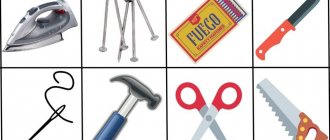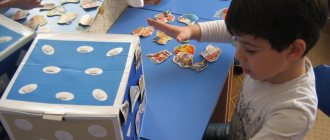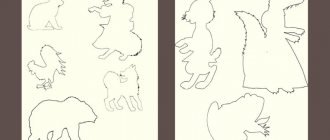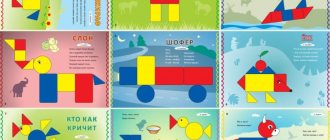TRIZ technology in kindergarten: we use it competently, we work creatively
Moreover, this thinking should have given not only correct, but also quick results.
This, according to G. Altshuller himself, was required by the scientific and technological revolution, the pace of which is accelerating, and the tasks being put forward are becoming more and more complex. It is natural that TRIZ has taken root in preschool pedagogy, has been transformed taking into account the age characteristics of little inventors, and is actively used in practice.
After all, regardless of who the child becomes in the future, a “techie” or a “humanist,” speed and correctness in making decisions in modern life will definitely be useful to him. Every child is initially talented and even brilliant, but he must be taught how to navigate the modern world in order to achieve maximum effect with a minimum of costs. G. S. Altshuller Heinrich Altshuller was convinced of the genius of childhood and cared about the fate of future generations. What ideas of Heinrich Altshuller can be applied in preschool pedagogy?
First of all, this is his idea of the creative and intellectual abilities of a person, and their role in solving problems of invention: Creativity is not a chaotic process, but a scientifically based one.
TRIZ game situations for children 3-4-5 years old
Good evening. I tried to write in the comments about TRIZ games. But many letters are not published. These are not exactly board games, or board games with creative elements. I’m publishing a post, I understand that it’s a little off topic for the community. If it's not at all right, I'll delete it. I will write game situations that were popular with children when I worked using TRIZ technology. There is also a card index of games and some photos, if you are interested I can post them.
Who lives in the little house?
Target:
teach the child the elements of analysis, encourage him to notice common signs by comparing them.
Will be needed
: colorful images of various objects (for example: pear, pen, house, backpack, pan, flower, and so on).
You can make these blanks yourself or make them with your children. A large box or closet is ideal for a mansion - the children’s imagination will tell them everything else.
Introduction:
recall the fairy tale “Teremok” with the children and offer to act it out as they do in the land of Changelings.
Progress of the game:
Each child, with his eyes closed, draws out his drawing and plays with the drawn object.
The presenter chooses the owner of the tower - the Changeling King, who has called his friends to a feast. The characters take turns approaching the tower. The first invitee asks a question: “Knock, knock, who lives in the little house?”
- I am ... (calls himself, for example, a flower).
And who are you?
- And I am ... (calls himself, for example, a pear).
Will you let me into the little house?
“I’ll let you in if you tell me how you’re like me.” The guest carefully compares the two drawings and names the common points found.
For example, he may say that both the flower and the pear have a branch. After this, the first participant enters the mansion, and the next guest is already knocking on the owner’s door.
It is important to maintain a friendly atmosphere: if someone cannot answer, then the rest of the children help.
A drawing refers to a card with a picture of an object.
"Masha the Confused"
Target:
train attention, the ability to see all the necessary resources.
Before the game, it is important to include TRIZ elements. In kindergarten this is not difficult to do, since a huge number of different objects are offered to the child’s attention. You can ask, pointing to an object: “What is this cup for? What is the door for? What is this pillow for?
Introduction:
tell children about absent-minded and forgetful people who confuse and forget everything (don’t forget to draw an educational conclusion).
Progress of the game:
And then ask: who wants to help the confused Mashas? The game can then be played in two ways as desired. The host will be Masha. Looking around in confusion, he says:
- Oh!
- What's happened?
- I lost (names an object, for example, a spoon). What am I going to eat soup with now (or call any other action)?
Sympathetic helpers begin to offer their own ways to solve the problem: you can take a cup and drink the yushka, and then eat the rest with a fork, etc. 2. The development of the game occurs in the same way as in the first, but the role of Masha the Confused is played by different children, and not only the presenter.
For example, whoever suggested the best alternative to a lost item becomes Masha. This ensures the activity of all participants in the game.
You can also use cards here. I used cards with older children, and with little 3-year-olds, objects, toys from Kinder, from toys, from construction sets.
TRIZ plus
Rolled onto the blue path. What has Kolobok become now? What does it look like?
And everything around also became blue (look through blue glass or plastic). Kolobok took some blue paint (felt-tip pen, pencil) and rolled on. Rolled onto... what track?
(green) and became what? What does he look like now? Kolobok took some green paint (felt-tip pen, pencil) and rolled on. Rolled onto... the yellow track. What has he become? What does it look like? At the end of the lesson, Kolobok gives the children all the paints (markers, pencils) and invites them to draw (or color pictures prepared in advance). Similarly, Kolobok travels along other paths, changing in shape, size, and material. To reinforce the material, didactic and board games are included in the group: “Hide the Mouse”, “Fix the Blanket”, “Match by Color”, “Match by Shape”, “Inserts”, etc.
Options for the game “Hide the Mouse” Options
What principles is TRIZ based on?
TRIZ is fundamentally different from traditional pedagogy in that it gives children much more independence. If in traditional pedagogy the main methods are “do as I do” or “do as I said,” in TRIZ the main task of adults is to stimulate the child’s curiosity.
Of course, in exceptional cases, strict prohibitions and instructions on what to do and what not to do are justified. For example, when a child tries to insert a nail into an electrical outlet. However, it will be better if the environment in which the child is located excludes such excesses and the very need for strict prohibitions and uncontested instructions.
It is much more far-sighted to create conditions in early childhood when a child can show curiosity without regard to possible prohibitions and discontent of adults. For the little ones who have just begun to crawl and walk, the optimal solution would be to create a closed space in which there will be no sharp corners, scratching objects and the same sockets.
By the way, this is exactly what the Italian doctor and teacher Maria Montessori (1870-1952), who developed her own system of working with children, advises to do. This system is described in the book “Children are different. A unique method of early development" [M. Montessori, 2014]. Moreover, such upbringing with a minimum number of restrictions and prohibitions does not at all abolish discipline. As the author of the method wrote in another book, a child raised according to her system “eats everything and does not bite” [M. Montessori, 2015].
She also believes that children should definitely be taught to clean up their toys and put them in the place where they got them. This is in addition to discipline. Develops observation and memory because children need to remember where the toy was in order to put it back. Note that the Montessori system and TRIZ principles in pedagogy have much in common.
Basic principles of TRIZ in pedagogy:
- Freedom of choice.
- Openness.
- Feedback.
- Action.
- Result.
You can also find other formulations of TRIZ principles. For example, focus on results is often called the “principle of priority of the developmental function” [T. Plungyan, 2020]. This does not change the essence, and all practical TRIZ methods fully comply with these fundamental principles.
Historical excursion
The author of the theory of solving inventive problems is the Russian inventor and science fiction writer Genrikh Saulovich Altshuller (1926-1998). You may not have come across TRIZ yet, but you’ve probably read Genrikh Altov’s book “The Scorching Mind” [G. Altov, 1968]. If so, we can assume that you are already familiar with the ideas of Heinrich Altshuller, which he generously shared both in fiction and in scientific research. Let us clarify that Genrikh Altov is the creative pseudonym of Genrikh Altshuller.
He began his development in the post-war years, and was soon joined by another inventor and part-time science fiction writer Rafael Borisovich Shapiro (1926-1993). He is known to fans of the science fiction genre as Rafail Bakhtamov, and his book “The Road to the Ocean” is loved by several generations of Russian readers [R. Bakhmatov, 1966].
As you can see, these people know everything or almost everything about creativity, and therefore who, if not science fiction writers, can share their experience in developing creative imagination. Moreover, their creative tandem put the process on a scientific basis, identifying patterns in the technology of inventing everything new. It turns out that each of us has everything necessary for creativity and invention, and we just need to be able to use it.
The first necessary step is a change in psychology, which the authors described in their article “On the psychology of inventive creativity” [G. Altshuller, R. Shapiro, 1956]. The TRIZ theory itself contains several dozen ready-made schemes and approaches to solving inventive problems that can be adapted to a specific situation.
Since today we are going to talk about TRIZ for children 4 years old and older, we will not delve into the depths of the theory and how this theory is used in science and technology. Those interested can independently study the regularly republished book “Introduction to TRIZ. Basic concepts and approaches" [G. Altshuller, 2011]. We will focus on the applied aspect of TRIZ in relation to pedagogy.





